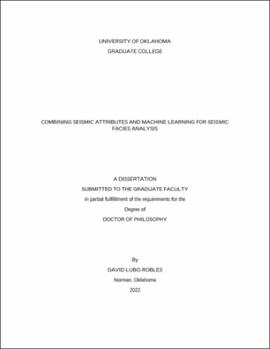| dc.description.abstract | Understanding how to correctly select a group of input seismic attributes is critical to perform a robust machine learning (ML)-based seismic facies analysis. However, due to the large number of seismic attributes enhancing different geologic features in the seismic volume and the fact that some of these attributes might offer redundant or irrelevant information, interpreters usually ask which the most optimal attributes are for their facies analysis and how the selected attributes might impact their results. In this dissertation, I evaluate three different strategies to address these challenges. In my first application, I introduce a novel technique called exhaustive probabilistic neural network (PNN), which combines an exhaustive search algorithm with a PNN to evaluate all possible combinations of seismic attributes and select the combination that best differentiates the target salt and nonsalt seismic facies in a 3D Eugene Island seismic volume located in the Gulf of Mexico. From seven candidate input attributes, the exhaustive PNN removed irrelevant attributes and found that a smaller group of four seismic attributes composed of the coherence, GLCM contrast, total energy, and dip deviation provided the most accurate result.
As a second approach, I apply Shapley additive explanations (SHAP) to understand how changes in the quality of the input seismic attributes might impact the predictions made by a random forest architecture trained to differentiate between mass transport deposits (MTDs), salt, and conformal siliciclastic sediments in the Gulf of Mexico. I found that the seismic attribute importance is dynamic and can change based on the facies analyzed and the quality of the input seismic amplitude and attributes data. Furthermore, I found that, the ML architecture learns a set of rules in multiattribute space to differentiate between the three facies, where seismic attributes measuring variations in energy and dip contribute most to the classification.
My third attribute selection workflow was based on the well-established use of principal component analysis (PCA). Here, my goal was to choose the best attributes for use in unsupervised gas hydrate facies analysis in a seismic volume located in the Blake Ridge, offshore South Carolina, USA. For attribute selection, I apply PCA considering three training data selection strategies. I found that using a balanced training data set - composed of the same number of samples per seismic facies – offered the best identification of the gas hydrate bottom-simulating reflectors (BSRs) and reduced the overlap with surrounding facies. A weakness of this workflow is due to PCA measuring the impact of individual seismic attributes instead of the optimal attribute combination, with the total number of attributes used subjective rather than quantitative. I use the selected attributes as input for self-organizing maps (SOM) classification.
After this evaluation, I find that the exhaustive PNN technique offers a robust implementation to quantitatively select the most optimal seismic attribute combination to perform a supervised seismic facies analysis, whereas SHAP provides the best insight not only into which attributes provide the highest individual importance in the classification, but also as to what attribute (e.g., anomalously high or low) value offers the best discrimination between the target facies, providing better insight into not only how the ML model works, but also in the underlying seismic expression of the geology. | en_US |
